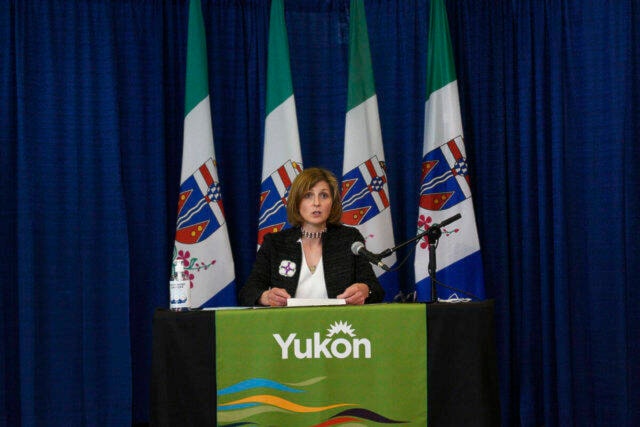Amid a flurry of new details on isolation and restrictions, the central message from the chief medical officer on Jan. 5 was to keep contacts as low as possible to limit Omicron spread across the territory.
“Already in Yukon, the numbers we’re seeing are high. High enough that there’s a very real risk of services being affected,” said acting chief medical officer Catherine Elliott.
“We only have four ICU beds so even if you don’t get vaccinated for yourself and even if you don’t follow the measures for yourself, even if you hate wearing a mask. Do it. Do it for your family,” she said.
Elliott said two people are currently in hospital with COVID-19 and the average daily count of new cases is 50 over the last seven days and 63 over the past three days.
Active cases rising in Whitehorse and communities
There are 325 active cases — an all-time high for the territory.
Active case breakdown per community is 263 in Whitehorse; 20 in Dawson; six in Tagish; five in Carcross; three in Pelly Crossing; two in Watson Lake; and one case each in Haines Junction, Old Crow and Teslin.
“These are unprecedented numbers for us,” said Elliott, adding that there is widespread community transmission and official case counts are much lower than the actual number. “This means that there is potential for exposure in most settings and most communities, and people would be wise to use their COVID-sense throughout the territory.”
“Over the long term, this actually is a step forward toward living with a milder form of COVID-19. And this means we can focus our efforts on those who most need it,” she said.
She said in order to prevent the healthcare system from being overwhelmed, people must limit their contacts, get their booster shots and follow the safe six.
She noted that the vaccines are still effective, but not as strong at preventing infection when it comes to Omicron. They still help prevent infection, hospitalization and severe health outcomes from the virus.
“Without these measures, our health system will very likely be overwhelmed,” she said. “Even with them, we will see a large number of people infected, but fewer than without.”
Healthy, vaccinated adults should isolate instead of testing
Testing protocols are also changing due to Omicron. Healthy adults who are vaccinated and have symptoms should now assume they have COVID-19 and isolate for the determined period without a test.
This will allow tests to focus on those more in need, said Elliott, including people at risk of severe disease, people with less immunity and those who work with vulnerable people, among others.
“We expect our testing system to become overwhelmed here too, and it’s getting there,” said Elliott. “I understand many people still want to test. They want to know. So we’re working hard on developing access to rapid home testing kits for those who want them.”
Elliott said around 5,000 rapid tests remain from the initial shipment from the federal government. Premier Sandy Silver said 100,000 more are on the way.
Elliott emphasized that rapid tests need to be used with caution.
“If you get a positive test result it means you have COVID-19. If you get a negative or indeterminate test result, it means you might have COVID, you might not. It doesn’t shorten your isolation. It doesn’t mean you can break the rules and gather with large numbers of people. It just means you might not have it,” she said.
Last Friday, additional public health measures were announced and will be enforced beginning on Jan. 7. Those include limits on gatherings, restrictions on restaurants and bars as well as recreation facilities.
Elliott explained in detail the restrictions in household gatherings.
For those who are fully vaccinated, the limit is 10 people from two households maximum. Fully vaccinated is defined as adults with two doses, children and teens with one dose. For those unvaccinated, gatherings are limited to a single household only.
The exception is for unvaccinated people who live alone, who are permitted to gather with one other household at a time.
New advice issued for group limits, isolation time
Limits on the amount of people in restaurants, bars, businesses, cultural and entertainment venues, and recreation facilities has also been implemented. Proof of vaccination is also required for most non-essential facilities.
Eliott said travel between communities should be for essential purposes only.
“We’re gonna have to learn to live with COVID-19,” she said. “We’re all going to have to learn to follow these rules, because they’re the right thing to do.”
Elliott said it’s important to plan ahead for isolation and missed days of work.
New advice has been released for new positive COVID-19 cases and will be posted online shortly, said Elliott. The length of isolation is dependent on vaccine status.
Those who have COVID-19 more than two weeks after a booster shot should isolate for seven days. If they have no symptoms, and aren’t taking fever medications, they can leave isolation and self-monitor for seven days.
The same advice applies to people who have had their second dose less than six months ago, as long as it has also been two weeks since that second dose.
The remainder of cases, including those who are unvaccinated, partially vaccinated or have gone longer than six months since their second dose, should self-isolate for 10 days.
Contact Haley Ritchie at haley.ritchie@yukon-news.com
